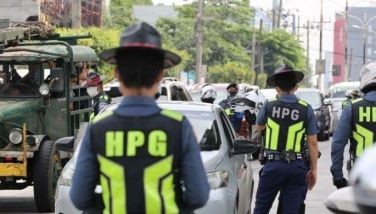Jeepney phaseout begins January 2018

A jeepney driver protests the government program to phase out jeepneys during a rally last September near the Land Transportation Franchising and Regulatory Board main office in Quezon City. Michael Varcas
MANILA, Philippines — It’s the end of the road for the country’s iconic jeepney.
Beginning next week, the Department of Transportation (DOTr) will remove jeepneys that are at least 15 years old from streets as part of the government’s transport modernization program.
DOTr Undersecretary Thomas Orbos yesterday said they would start taking out the “problematic” jeepneys beginning January – the start of a three-year transition period.
Orbos stressed they could not physically remove all old jeepneys from the road at the same time but over three years, or until 2021.
He said the DOTr will launch the Motor Vehicle Inspection System (MVIS) to determine the age of a jeepney and its roadworthiness.
Under the government’s modernization program, jeepneys 15 years and older will be replaced by electric-powered or Euro 4 compliant vehicles.
Euro 4 is a set of emission standards on particulate matter, carbon monoxide, nitrogen oxides and hydrocarbons.
The venerable jeepney, an icon of the post-war era, is powered by Euro 2-compliant engines.
Other proposed specifications for the improved public vehicles include closed-circuit television cameras, a GPS navigation system, automatic fare collection system, dash cameras and Wi-Fi.
The PUV modernization program seeks to phase out old and dilapidated jeepneys and replace them with high-quality transport systems that are environment-friendly and have greater capacity.
The program was officially launched on June 19. It is also seen as a solution to decongest the traffic-choked streets of the country’s urban areas.
Financial assistance
Transportation Secretary Arthur Tugade said the jeepney modernization program is “not-anti poor.”
Tugade said the program is not designed to phase out the jeepney or the business but to guarantee its profitability.
The government, under the Development Bank of the Philippines’ Program assistance to Support Alternative Driving Approaches (PASADA), promised to provide assistance amounting to P1.5 billion to transport firms and cooperatives to purchase new PUVs.
PASADA’s key features are the five-percent equity for vehicle purchase, six-percent interest rate and seven-year repayment period.
The eligible borrowers of the program include transport companies and cooperatives which have been qualified to receive franchise under the Omnibus Franchising Guidelines.
Under these guidelines, individual jeepney operators will not be granted a franchise if they are not part of a cooperative or consortium.
Transport groups, however, have opposed the scheme, saying small operators and drivers cannot afford to take on new loans to buy vehicles.
They argued the loan facility is not the solution to the problem.
They said the program will kill the small cooperatives and single-unit jeepney owners while the government will replace them with larger corporate-type franchises.
Transport groups also warned the current minimum fare of P8 would go up if the government pushes through with the program.
Transport groups like the Stop and GO Coalition and the Pinagkaisang Samahan ng Tsuper at Operator Nationwide (PISTON) said they support the rehabilitation of jeepneys but not the total phase out of the icon of the Philippine transport system.
The groups staged a series of transport strikes to show their opposition to the modernization program.
The government, however, remained unfazed and said it would continue the program, which officials said was “long overdue.”
President Duterte recently warned owners of old jeepneys to take their vehicles off the road by Jan. 1 or face arrest and have their units impounded.
Duterte said he is committed to pushing through with the jeepney modernization program and have the old smoke-belching jeepneys off the road by next year.
Heavier traffic by next year
Expect heavier traffic in 2018, especially in Metro Manila, as the government begins its massive infrastructure projects, Orbos said.
Orbos said they will start constructing all of the infrastructure projects in 2018, which will cause heavy traffic until the end of Duterte’s term.
“So many projects next year, which is part of the building program… they will all start simultaneously until the end of the term of the President,” Orbos said.
“In order for us to have better infrastructure, we need to go through this heavy traffic, which will start next year… Just remember we will all benefit from it,” he said.
Orbos said they will start constructing the Light Rail Transit Line 1 (LRT1) Cavite extension, the Light Rail Transit Line 2 (LRT2) East extension, Metro Rail Transit Line 7 (MRT7) and the North Luzon Expressway (NLEX) Harbor Link Segment 10 in Caloocan City and several bridges in Metro Manila.
He said most affected by the traffic is the entire stretch of EDSA.
Orbos said the DOTr is closely working with the Department of Public Works and Highways (DWPH) and the Philippine National Police-Highway Patrol Group (PNP-HPG) to ensure that traffic remains manageable.
With the looming horrendous traffic, Orbos, who is also the general manager of the Metropolitan Manila Development Authority (MMDA), appealed for understanding as he emphasized the problem is part of the long-term solutions to the traffic.
“There are already corresponding actions of the government to address this not in terms of traffic decongestion, but we are looking at permanent solutions in the long run,” he said.
For the meantime, the public should be more patient, he said.
Bong Nebrija, operations supervisor of the MMDA, said they will work closely with the DOTr and other agencies responsible for the infrastructure projects to ensure the traffic will not cause so much burden to commuters.
“If the projects start at the same time, it will really pose a challenge to us, “ Nebrida said. “We will try to manage it, but not only with MMDA… it’s a collective effort.”
Nebrida said they will have to implement re-routing schemes to ensure motorists would have more options on the road.
- Latest
- Trending






























